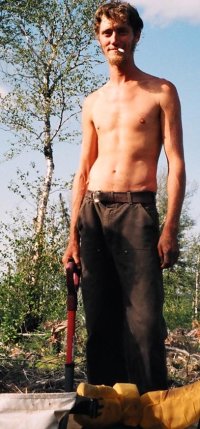By: Jacklyn Killins


|
-prev |
~~ lba ~~ | next- |

|
On Jan. 9 Aaron Veldstra woke in a hostel in Southern California. He ate a free breakfast of pancakes and jam and boarded a trolley to the Mexican border. He arrived at the border 45 minutes later and with a glance at an enormous Mexican flag flapping in the wind beyond the razor-wire-topped fence, he turned around, put one foot in front of the other, and took the first step on his walk up the West Coast toward Canada. Along the way the 25-year-old from Vancouver is investigating the North American car culture, all the while trying to figure out a solution for the pressing environmental issue of the overuse of cars. “I’m walking for the cure from cars,” he said in a telephone interview Jan. 24. Cars are useful, but they use fossil fuel and create more problems than solutions because they are in such wide use, Veldstra said. “I think they’re a good idea, it’s just they’re old technology.” This is not Veldstra’s first long distance journey by foot. In 2004 he walked from Vancouver to Calgary and in the fall of 2005 he walked across Newfoundland. Veldstra’s experience working at a scrap yard opened his eyes to the side of cars not a lot of people see, spurring his desire to walk. “It’s horrible watching cars die, it’s almost worst than seeing something natural die. They spill their fluids all over the place and all those fluids aren’t biodegradable.” Walking takes time and so does change. While Veldstra walks he has a lot of time to think about a solution, he said. “It’s the age-old method of deduction, going for a long walk. Who knows, maybe I will actually solve it.” Veldstra has the enthusiasm of an idealist and the wisdom of a philosopher. He is hopeful, yet realistic. “I don’t think I’m actually going to cure cars per se, I’d rather just get the idea out there and propagate that as opposed to trying to actually stop people from driving because I know that’s never going to happen.” If you are not willing to give up you car there are still ways to contribute to curring the car plague. Danny Power of Capital Honda in Charlottetown said the provincial government offers buyers of hybrid cars a provincial tax break of up to $3,000. Hybrids are not just for environment enthusiasts anymore, all kinds of people buy them, including government officials who want to set a good example, Power said. “Last year was the biggest year ever for hybrid sales.” This is good news in a rural province that, according to Statistics Canada, has the highest percentage of people who drive to work because the low population doesn’t support a widespread public transit system. Veldstra suggests Islanders look into car-pooling. It would save money and help the environment. “Just get these single occupancy vehicles off the road. Jam as many people as you can into that one car, ” he said. During the day Veldstra walks a landscape that revolves around the car. He is forced to the fringes, forced to tresspass by walking along train tracks or along highways. In his travels he rubs elbows with the marginalized members of society. A lover of conversation, and not one to judge or to pass by without a smile, Veldstra often sparks conversations with homeless people. We have a lot to learn from people in diffeerent economic situations, he said. Most people he encounters on his stroll agree with his purpose. “It’s odd there’s no real fight. It’s like everyone knows these things are killing the planet and they want to change it, but there is no solution there.” When night falls on his journey Veldstra sometimes treats himself to a motel room. More often he rolls himself up in his sleeping bag and tarp, much like a human size version of the burritos he’s been living on, and sleeps on the earth. One night he found a bridge close to the ocean where he sat and played his harmonica and listened to the waves before falling asleep. Another night he slept on a steep hill and, despite using tent pegs to hold his tarp over him, he woke up every few hours and had to claw himself back up under his tarp. Not everyone has the time to walk everywhere but the P.E.I Active Living Alliance has created a challenge to motivate workplaces on the Island to walk more using pedometers. A particiapant in this Walk for Fun in the Sun challenge, Karen Mair of the CBC Radio team the Walkie Talkies, said this challenge is mostly about active living but people may end up choosing not to use their cars as a result. Mair said pedometers, originating in Japan, have been recognized for years as a great motivational tool. “You start looking at this thing and realize, ‘Oh my God I’ve hardly moved today.’” There are many ways to help in the cure for cars, but Veldstra urges people not to forget the obvious mode of transportation, walking.
“All you have to do is just put on a pair of shoes, walk to the store, have a nice wander around, look at the birds and stuff. You know, it’s good for the soul.”
 thanks for the flattering photography |

| -prev | A Californian Saunter | next- |
